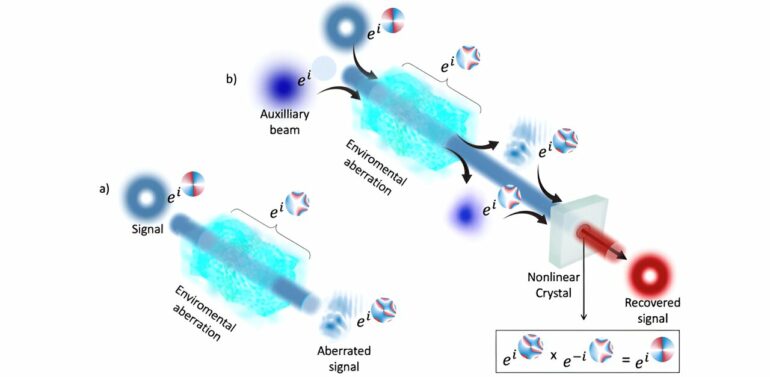The many properties of light allow it to be manipulated and used for applications that range from very sensitive measurements to communications and intelligent ways to interrogate objects. A compelling degree of freedom is the spatial pattern, called structured light, which can resemble shapes such as donuts and flower petals. For instance, patterns with different numbers of petals can represent letters of the alphabet, and when observed on the other side, deliver the message.
Unfortunately, what makes these patterns sensitive for measurements also make them susceptible to unwanted environmental factors such as air turbulence, aberrated optics, stressed fibers, or biological tissues doing their own “patterning” and distorting the structure. Here the distorted pattern can deteriorate to the point that the output pattern looks nothing like the input, rendering them ineffective.
Conventional methods to correct this have needed one to reapply the same distortion—this can take the form of measuring the distorting and applying the reverse or reversing the distortion in the beam and resending it back into the aberration, allowing this to “undo” itself in the process.
In a collaboration between South Africa and Italy, researchers have now shown it is possible to correct aberrated light coming out of a noisy environment to be the same as before by simply pairing it with another unstructured beam of light that experienced the same aberration. Using a range of optical distortions, they showed that passing them together into a nonlinear crystal naturally results in light correcting light, even for very complex forms of the aberrations that rendered the initial structure unrecognizable.
As reported in Advanced Photonics, the researchers achieved this by exploiting a process called difference frequency generation, where two beams of light sent into a special type of material, known as a nonlinear crystal, create another beam which shares the properties of the two inputs. Most pertinently, the output aberration is the difference of the two input aberrations, so that if they are the same then light can correct light—with an after-crystal output that is aberration free.
An exciting aspect of this work is that the correction is automatic and travels with the signal so that patterned light can be corrected in real time, without the need for knowing what the disturbance is or needing to reapply the same aberration with other more complex steps. This makes for a ready and compact solution that can be integrated into systems that use these structures for diverse applications, ranging from communications to imaging and optical trapping.
As a byproduct of the process, there is an added advantage of communicating and detecting with different wavelengths; for instance, sending information with eye-safe wavelengths, or interrogating biological samples at penetrating wavelengths, while detecting at wavelengths where technology is well developed for observation.
More information:
Sachleen Singh et al, Light correcting light with nonlinear optics, Advanced Photonics (2024). DOI: 10.1117/1.AP.6.2.026003
Citation:
Researchers develop method to manipulate structured light without distortion (2024, March 5)
